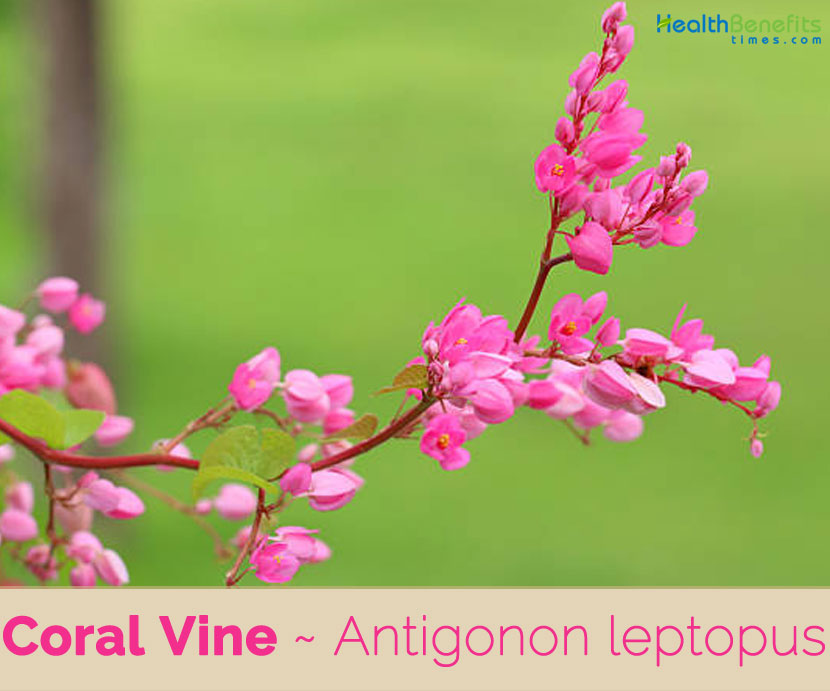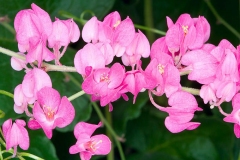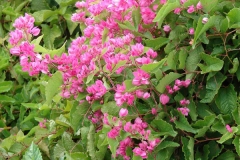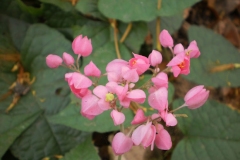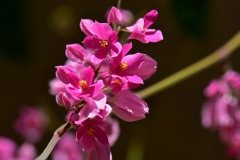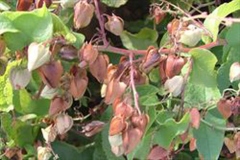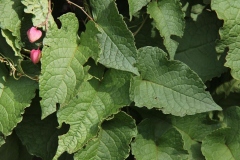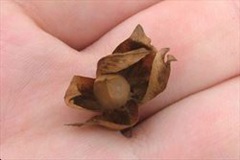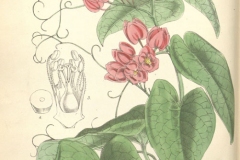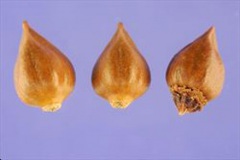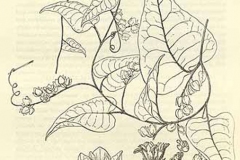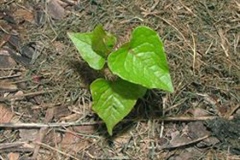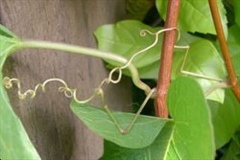| Coral Vine Quick Facts | |
|---|---|
| Name: | Coral Vine |
| Scientific Name: | Antigonon leptopus |
| Origin | Mexico (Baja Sur, Chihuahua, Guerrero, Jalisco, Michoacan, Nayarit, Oaxaca, Sinaloa and Sonora) |
| Colors | Brown |
| Shapes | Conical and 3-angled achene 8–12 mm long and 4–7 mm wide, shining |
| Health benefits | Beneficial for diabetes, low blood pressure, flu, menstrual pains, cough, sore throat, asthma, liver and spleen disorders and heart disease |
| Name | Coral Vine |
|---|---|
| Scientific Name | Antigonon leptopus |
| Native | Mexico (Baja Sur, Chihuahua, Guerrero, Jalisco, Michoacan, Nayarit, Oaxaca, Sinaloa and Sonora), now common in warm tropical countries globally |
| Common Names | Bride’s Tears, Chain-of-Love, Chinese Love Vine, Confederate Vine, Confederate-Vine, Coral Bells, Coral Creeper, Coral Vine, Coralita,
Corallita, Coral Vine, Hearts on a Chain, Honolulu Creeper, Love Chain, Love-Vine, Mexican Coral Vine, Mexican Creeper, Mexican-Creeper, Mexican Love Vine, Mountain Rose, Mountain-Rose Coralvine, Mountain-Rose Coralvine, Pink Vine, Queen’s Jewels, Queen’s Wreath, San Miguelito Vine, Sandwich Island Creeper, coral rose vine, Mexican rose, mountain coral vine |
| Name in Other Languages | Afrikaans: Koraalranker Australia: Coral creeper Bahamas: coralline Bengali: Anantalata (অনংতলতা) Brazil: Amor agarradinho Chamorro: Cadena De Amor, Flores Kádena Dominican Republic: Bellacima, bellacina, Carolina, copalina, guirnalda, guirnalda Americana Dutch: Engletåre English: Confederate-vine, coral vine, Mexican coral vine, Mexican creeper, Chain-of-love, Mountain-rose coralvine, Queen’s jewels, Queen’s wreath, hearts on a chain, love-vine, mountain rose, cemetery vine, corallita, St James’ flower, St Michael’s flower, bee bush, San Miguelito vine, queen’s wreath, Bride’s Tears Finnish: Koralliköynnös French: Rosa-De-Montana, Antigone, liane antigone, liane corail, antigone à pied grêle, belle mexicaine, liane aurore German: Mexikanischer Rosenknöterich, Haiti: Belle mexicaine, pois-et-riz, Bèl meksikèn Hebrew: אנטיגון דק-עוקצים Hungarian: Korall-lián Indonesia: Bunga Air Mata Pengantin Jamaica: Coralila, Coralita Kannada: Āṇṭigonān (ಆಂಟಿಗೊನಾನ್) Lesser Antilles: Bee bush, cemetery vine, cercle barril, la belle mexicana, lyann barril, zeb semitye Malayalam: Tēnpūvaḷḷi (തേൻപൂവള്ളി) Malaysia: Honolulu Creeper, Bunga Bonet, Bunga Berteh Mexico: Kadena De Amor Micronesia, Federated states of: Love vine, rohsenpoak suwed Northern Marianas Islands: Flores Ka-dena Palauan: Dilngau Papiamento: Beyisima Philippines: Cadena-De-Amor, Cadena-De-Amor, Flores De Singapore Pohnpei: Rohsapoak, rohsenpoak suwed Portuguese: Amor Em Penca, Amor Entrelacado, Amor-Agarradinho, Coralia, Coralita, Entrada De Baile, Georgina, Mimo Do Ceu, Rosa De Sao Miguelito, Rosalia Puerto Rico: Bellosinia, coral, coralina Spanish: Bellísima, Corazon Bello, Corona, Coronilla, Kadena De Amor, Rosa De Montana, bellísima, cadena de amor, coral, coralilla, coralillo, coralillo rosado, coralita, pensamiento, bellosinia, cadena de amor, colación confite, coralito, corallita, Coralina Swedish: Rosensky Tamil: Kodi Rose, Koṭi rōjā (கொடி ரோஜா) Telegu: Picchibatani Thai: Puang Chom-Poo (พวงชมพู) Tongan: Ufi, Sēiniʻoeʻofa United States Virgin Islands: Love chain Vietnamese: Dây Ti Gôn; Hiếu Nữ; Hoa Tigôn, Nho Hoa, Ti gon |
| Plant Growth Habit | Fast-growing, climbing, somewhat woody, robust vine |
| Growing Climates | Pine rock lands, rock land hammocks, tropical hardwood hammocks, scrub, maritime forests, and swamps, waterways and riparian areas, monsoon vine thickets, rainforest margins, coastal sand dunes |
| Soil | Prefers near-neutral to alkaline soils with pH of 6.1–7.8, moderately fertile sandy or light soils with moderate moisture level |
| Plant Size | About 6-10 m tall, occasionally reaching up to 15 m in height |
| Stem | Branched, angular in cross-section, and either hairless (glabrous) or sparsely to densely covered in brownish or reddish hairs |
| Leaf | Cordate–ovate, hastate–ovate or triangular (2.5–9 cm) leaves. The leaves are borne on short often winged, glabrate petioles and have reticulate venation, cordate base, ciliate margins and acute to acuminate tips |
| Inflorescence | Inflorescence 4–20 cm long panicle with clusters of white or pink flowers along the rachis which has a tendrilate tip |
| Flowering season | April to May |
| Flower | Flower with ovate to elliptic tepals with entire margins and acute apex on 3–10 mm glabrous or pubescent pedicels |
| Fruit Shape & Size | Small brown fruit (achenes) are cone-shaped or three-angled and are 8-12 mm long and 4-7 mm wide having shiny appearance |
| Fruit Color | Brown |
| Propagation | Sexually by seeds, and also vegetatively by stems, plant fragments, tubers, and root suckers |
Plant description
Coral Vine is a fast-growing, climbing, somewhat woody, robust vine that climbs using tendrils at the end of the inflorescence axes and attains height about 6-10 m tall, occasionally reaching up to 15 m in height. The plant is found growing in disturbed areas, coastal cliffs, coastal forests, dry to moist lowland forests in warm tropical and subtropical regions, pine rock lands, rock land hammocks, tropical hardwood hammocks, scrub, maritime forests, and swamps, waterways and riparian areas, monsoon vine thickets, rainforest margins, coastal sand dunes, mangrove vegetation, roadsides, waste areas, old gardens and banks of watercourses. The plant prefers near-neutral to alkaline soils with pH of 6.1–7.8, moderately fertile sandy or light soils with moderate moisture level. It is drought tolerant; once established it needs occasional water.
Stem
Stems are puberulent, pentagonal, with many lateral branches. The slender stems climb up or sprawl over other vegetation by means of tendrils that are borne in the leaf forks (axils). They are branched, angular in cross-section, and either hairless (glabrous) or sparsely to densely covered in brownish or reddish hairs (pubescent). Older stems may sometimes become brown and woody towards the base of the plant, while younger stems are reddish-brown or green in color.
Leaves
The alternately arranged leaves are simple and borne on stalks (petioles) 1-5 cm long. These stalks are sometimes slightly winged and have a very small membranous structure (ochrea) 0.2-2 mm long at their base. The leaf blades are 2.5-15 cm long and 2-10 cm wide and are either egg-shaped in outline with broad end at base (ovate), heart-shaped (cordate) or somewhat triangular in shape. The lower ones are usually larger and broader, while the upper ones are smaller and narrower. These leaves may have either entire, wavy (undulate) or bluntly toothed (crenate) margins and the tips are usually pointed (acute to acuminate apices). They may be hairless (glabrous) or somewhat hairy (pubescent), especially along their veins on their undersides. The leaves are light to dark green in color, have a strongly wrinkled (rugose) appearance, and are lined with a network of veins (they are reticulately veined).
| Leaf arrangement | Opposite/sub opposite |
| Leaf type | Simple |
| Leaf margin | Undulate |
| Leaf shape | Ovate |
| Leaf venation | Pinnate |
| Leaf type and persistence | Deciduous |
| Leaf blade length | 2.5-15 cm |
| Leaf color | Green |
| Fall color | No fall color change |
| Fall characteristic | Not showy |
Flowers
Flowers are borne in unbranched, or more commonly branched, clusters at the tips of the branches (in terminal racemes or panicles). These flower clusters are 4-20 cm long and have hairy stalks (puberulent to pilose peduncles) and the flowers are arranged into small groups along the branches (with 1 to 4 flowers in each group). Tips of the flower clusters usually end in a short tendril. Individual flowers are borne on smaller stalks (pedicels) 3-10 mm long and each flower has five ‘petals’ (sepals or perianth segments) that are usually bright pink in color, but may occasionally be white or reddish. These petals are 4-10 mm long and 2-6 mm wide and have entire margins and pointed tips (acute apices). They also have eight stamens and an ovary topped with three styles and stigmas. Flowering may occur throughout the year, but is most prominent during autumn (i.e. from April to May).
| Flower color | Bright pink, but may occasionally be white or reddish |
| Flower characteristic | Summer flowering; pleasant fragrance; fall flowering; spring flowering |
Fruit
The small brown fruit (achenes) are cone-shaped or three-angled and are 8-12 mm long and 4-7 mm wide having shiny appearance. These fruit usually remain hidden within the enlarged and persistent remains of the petals that are 8-20 long and 4-15 mm wide, which turn dull pink and then eventually brown as they age.
| Fruit shape | Cone-shaped |
| Fruit length | 8-12 mm |
| Fruit cover | Dry or hard |
| Fruit color | Unknown |
| Fruit characteristic | Inconspicuous and not showy |
Ethno-medicinal uses of Coral Vine
| Geographical area | Uses |
| Iloilo, Philippines | Gastrointestinal disorders |
| Amarkantak region, M.P., India | Paste made from fresh leaves is applied externally in skin problems. |
| Pratapgarh tehsil, Rajasthan, India | Seeds are used as famine food; leaves are used to treat blisters |
| Malayali tribals, Eastern Ghats, Tamil Nadu, India | Seeds are used in diabetes. |
| Fatehpur, UP, India | Decoction of aerial parts used for prevention of cough and flu related pains. |
| Trinidad and Tabago | Diabetes |
| Nigeria | Antimicrobial |
| Sonora, Mexico | Leaves and roots used in stomachache |
| Himalayan region, India | Medicinal |
| Irula tribes, Walayar valley, Southern Western Ghats, India | Decoction made from roots orally to treat dermatological infections/diseases |
| Burhanpur district, M.P., India | Leaves are used in skin diseases. |
| Bhil tribe of Alirajpur district, M.P., India | Flower is used in pain and cold; leaf is used in blood pressure and as heart tonic. |
| Eastern Nicaragua | Root is used as food and medicine |
Traditional uses and benefits of Coral Vine
- Leaves are used in Caribbean folk medicine as poultices for boils and swellings.
- Coral Vine has been used in traditional medicine for diabetes and low blood pressure and as a heart tonic in Trinidad and Tobago.
- Tea from the leaves is used for hypertension, diabetes, flu and menstrual pains.
- Hot tea prepared from the aerial parts of Coral Vine is used traditionally for the prevention and treatment of cough, sore throat and flu-related pain in the West Indies.
- It is used as a poultice and locally called ‘riang-riang’ inn Sumatra.
- In the Philippines, an isolated report stated it is used by Ifugao migrants in the foothills of the Sierra Madre for wound closure.
- Root extract has been used to treat asthma, liver and spleen disorders in Nigeria.
- An extract of its leaves and flowers prevent lipid peroxidation.
- Aerial portion of the flowers used in decoction as a cold remedy.
- Decoction of aerial parts used as a remedy for colds and pain relief.
- In Jamaica, decoction of aerial parts traditionally used for prevention of cough and flu-related pains.
- In Sudan, leaves used for cough and throat constriction.
Culinary Uses
- Leaves and pink flowers are often eaten as cooked vegetables in Thailand.
- In Thailand, the leaves and flowers are dipped in flour, fried and served with vermicelli.
- The flowers are also mixed into omelets.
- Herbal teas are made from the leaves and blossoms.
- Small tubers are edible and are valued in its native area for the nut like flavor.
- Tuberous roots are edible and are consumed by the local populations in famine periods.
Other facts
- Coral Vine is a very good ornamental plant with amenity value.
- The flower inflorescence is used for floral arrangement.
- Its flowers provide a very good source of nectar and pollen, extensively visited by honey bees also visited by a variety of solitary bee species, such as carpenter bees.
- It also provides a light brown-colored honey which has a pleasant aroma and flavor.
- Coral vine (Antigonon leptopus) is regarded as an environmental weed in the Northern Territory, Queensland, and Western Australia and on Christmas Island.
- Flower clusters are popular for use in flower and foliage arrangements for social functions.
- Mexican Creeper is cultivated as an ornamental vine to climb up, on and over fences, walls, pagodas and arbors to cover them and to create a showy display of foliage and flowers.
References:
https://www.itis.gov/servlet/SingleRpt/SingleRpt?search_topic=TSN&search_value=20994#null
http://www.hear.org/pier/species/antigonon_leptopus.htm
http://www.missouribotanicalgarden.org/PlantFinder/PlantFinderDetails.aspx?kempercode=a486
https://plants.usda.gov/core/profile?symbol=ANLE4
https://www.cabi.org/isc/datasheet/112316
https://en.wikipedia.org/wiki/Antigonon_leptopus
https://edis.ifas.ufl.edu/fp043
https://keyserver.lucidcentral.org/weeds/data/media/Html/antigonon_leptopus.htm
https://davesgarden.com/guides/pf/go/2050/#b
http://www.theplantlist.org/tpl/record/kew-2642295
https://www.monaconatureencyclopedia.com/antigonon-leptopus/?lang=en
https://indiabiodiversity.org/species/show/266356
https://gd.eppo.int/taxon/AIGLE
http://tropical.theferns.info/viewtropical.php?id=Antigonon+leptopus


